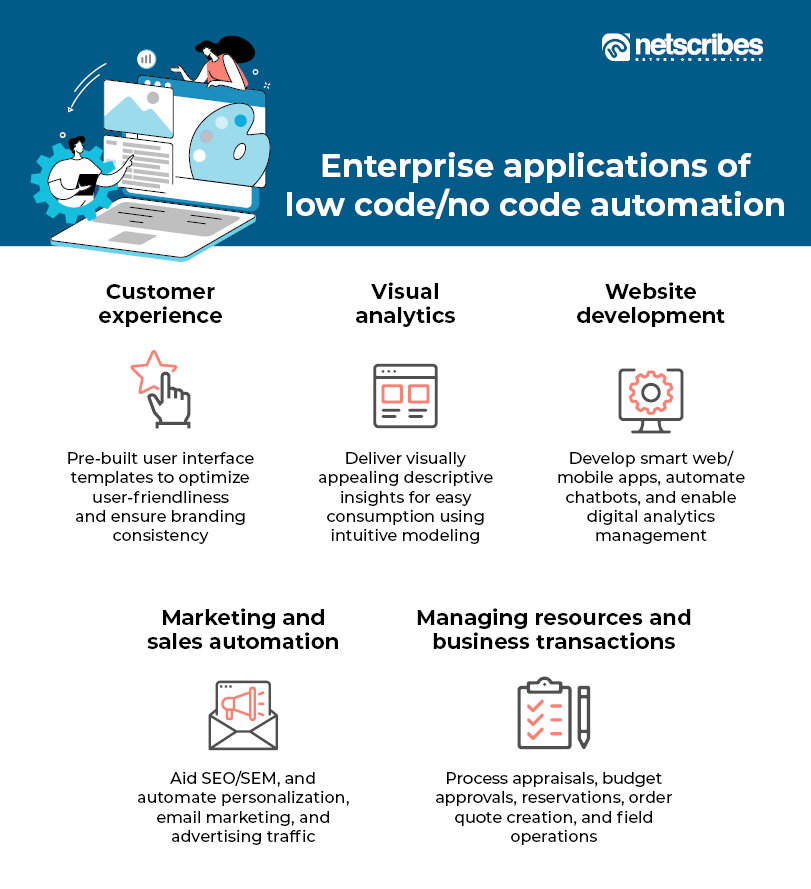Great News To Picking Legacy application modernization with Low-code
Great News To Picking Legacy application modernization with Low-code
Blog Article
Speed-WiseLow-Code Applications Have Many Advantages.
Visual Development Environment:
Drag-and-Drop Interfaces: Low-code platforms provide visual tools for designing applications. Drag-and-drop elements can be used by developers to build apps quickly with no code.
Many low-code platforms include pre-built templates and components that enable developers to quickly prototype applications and then build them without needing to start with a blank slate.
Reduced Coding requirements:
Automated Code Generation Low-code platforms automatically create the underlying code based on the visual models designed by developers. This eliminates the need to write the code manually and speed up the process of developing.
Reusable Components : Developers are able to reuse components in various projects to cut down on the amount of time they spend writing and testing codes.
Collaboration Streamlined:
Low-code development platforms are typically equipped with tools, such as version control, deployment and testing. This allows for seamless collaboration between teams.
Citizen development: Through the use of intuitive interfaces and reducing bottlenecks that are often caused by lack of developers, business users and other users can help in the development of applications.
Rapid Iteration & Prototyping
Rapid Prototyping Developers can swiftly build prototypes for ideas to be validated and feedback to be gathered, resulting to faster iteration.
Simple modifications. The visual nature low-code development gives makes it simple to upgrade and modify applications. This speeds up the process of enhancing and improving applications by incorporating user feedback.
Pre-built Integrations:
API Integrations. Low-code platforms usually have pre-built connectors and APIs for the most popular services which can reduce the amount of time required to integrate other systems.
Data Integration: The tools that are built within the software ease and accelerate the process of linking databases, other data sources and applications.
Scaling, deployment and deployment
One-Click deployment: Many platforms that make use of low-code have a one-click option for deploying applications, which can reduce time and effort.
Cloud-based Solutions: Cloud platforms with low-code enable developers to focus on the functionality and logic of their apps instead of worrying about deployment logistics.
Overall, the benefit of developing low-code applications in terms of speed is in the ability of it to automatize and simplify many aspects of the development process, enabling faster delivery of applications and quicker adaptation to changing requirements. Take a look at the top over here on Low-code Platform for application development for blog recommendations including low code development platforms, application development platforms, develop mobile application, push notifications, app modernisation, push alerts, cross platform app development, application modernization software, cross platform mobile app development, cross platform mobile dev and more.
Low-Code Software Is Cost-Effective.
Low-code applications offer a variety of advantages in terms of cost-effectiveness. Businesses that are trying to cut costs can take advantage of this method while still delivering high-quality applications. These are the major benefits reduction in development costs:
Lower Coding Requirement: Low programming platforms eliminate the requirement to code by hand and save developers time and money. This results in lower costs for labor.
Fewer Developer Resources: Since low-code development is quicker and simpler, less specialized developers are required. It could reduce the cost of hiring and staffing.
More Time To Market
Accelerated cycle of development Visual tools for development as well as pre-built components offered by platforms that use low-code allow rapid application development, allowing companies to deliver products to market more quickly. This can result in quicker revenues and better competitive positioning.
Rapid prototyping. Through the rapid creation and testing prototypes businesses can speed up developing and develop faster on user feedback.
Lower maintenance costs:
Simplified Maintenance: Applications built on low-code platforms tend to be simpler to maintain because of their standardized components and modular architecture. This means that they are less likely to require ongoing maintenance and support cost.
Automated Updates Many low-code systems are capable of handling updates and patches in a manner that is safe and efficient. This means there is no necessity for manual intervention.
Efficient Resource Utilization:
Contributions from Non-Developers Low-code platforms permit both developers and business users to be part of the development process. This is a way for developers to be more democratic and allows businesses and employees to work together, thus reducing the dependence on highly paid developers.
IT Departments can Focus on Strategic Initiatives: Instead of being caught up in routine development tasks IT departments can focus their efforts on strategic initiatives that improve productivity and efficiency.
Price models that are scaleable:
Subscription-Based Prices: Many lowcode platforms offer flexible, subscription-based price models that increase in line with usage. Businesses are able to adjust their spending in line with their growth and needs, without incurring large upfront costs.
Pay-Assosiated Alternatives: Some platform providers offer pay-assosiated options. They ensure that businesses pay only for the resources utilized which is advantageous to startups and small business that have limited resources.
Costs for reduced Third-Party Software:
Built-in Functionalities : Low-code software usually comes with built-in functionality and integrations which reduces the requirement for third-party tools, software and licenses.
Pre-Built Intergrations: The ability to use pre-built integrations and pre-built integrations for popular systems and services reduces the need for custom development and saves time and money.
ROI Improved:
Faster ROI: Businesses can get a better return on investment from their applications by combining rapid development, reduced costs, and faster times to market.
Increased agility: Businesses are able to adjust quickly to changes in the market or in customer demand, which allows businesses to stay relevant and make the most of new opportunities.
Lower Cost of Training
Low-Code platforms have user-friendly interfaces. The simple and user-friendly interfaces help ease the learning curve for new users. This eliminates the need for intense training programs.
Accessible Resources: Many low-code platforms offer comprehensive tutorials and training materials along with community support. These resources reduce the requirement for formal education and its associated cost.
Streamlined collaboration:
Enhance Collaboration Tool: The built-in collaboration tool helps improve communication and cooperation among team members. This leads to more efficient development processes, and decreases the project's overhead.
Unified Development Environment : A unified environment simplifies work flows and reduces the costs associated with managing various tools and platforms.
The overall cost-effectiveness of software development using low-code can be attributed to its ability to cut down on the cost of maintenance and development, increase time to markets, optimize resource use, and provide flexible price models. These elements provide huge economic benefits to companies. Low-code is a fantastic choice for organizations that want to maximize budgets but still build robust, scalable, and high-quality software. Check out the best Legacy application modernization with Low-code tips for more tips including develop web application, rapid application design, cross platform mobile app development, application development platforms, push notifications, ms azure sql, application modernisation, azure sql databases, app platforms, cross platform mobile development and more.
The Benefits Of Low-Code Programming For Vendors And Community
Low-code platforms provide significant benefits in terms of community support and vendor support and vendor support, both of which are crucial to the successful implementation, maintenance, and further improvement of apps. Here are a few main benefits: Vendor support
Comprehensive Technical Support:
Support Teams: Many platforms that use low-code provide special support teams that assist with technical problems, troubleshooting and guidance.
24/7 Support: Some vendors are available around the clock, which is beneficial to businesses that operate in multiple time zones.
Training and Onboarding
Structured Training: Many providers offer structured training including webinars, tutorials and certification courses to assist users to quickly get comfortable with the platform.
Customized Onboarding : Many companies offer customized onboarding which assist new customers implement the platform and customize it according to their specific requirements.
Regular updates and enhancements
Continuous Improvement : Low-code platform vendors often release regular upgrades that include new functionality as well as performance improvements and security patches. These updates make sure that their platform remains up to date and secure.
Feedback integration: Vendors will frequently incorporate feedback from users during their development cycle to make sure the platform meets the evolving requirements of users.
Comprehensive Documentation:
Comprehensive Documentation: A comprehensive and well-organized documentation is usually available, covering everything from basics to advanced customization, which allows users to solve problems on their own.
API References: Comprehensive API documentation assists developers in integrating the low-code platform with other systems and to customize their applications effectively.
Professional Services and Consulting:
Expert Consultation. Vendors offer a wide range of services for consulting, such as architecture design as well as strategic planning, and even complex platform implementations. These services ensure users can maximize the potential of their platform.
Custom Development Services: Certain companies provide custom development services to build specific features or integrations that are not included in the default.
Community Support
Active User Community:
Forums and Discussion Boards: A lot of low-code platforms offer vibrant online communities where users can seek answers, discuss solutions, and collaborate on best practices.
User Groups and Meetups Virtual and local user groups and meetups provide opportunities for networking, learning and sharing your experiences with other users.
Knowledge Sharing and Collaboration
Community-Contributed Resources: Users often share templates, modules, and extensions that they have developed, which can be reused or adapted by others, accelerating development and innovation.
Crowdsourced Solutions: The collective wisdom and experience of a community may prove to be a useful tool in problem-solving and finding innovative solutions.
Learning and Development:
Community-Led Learning: Many communities hold training sessions, workshops and webinars that are often led by users with experience who can share their knowledge and more advanced methods.
Online Tutorials and Courses: Users of the community often share and create online tutorials, classes and guides on how to do things that help students learn more.
Feedback and Influence
Forums for Product Feedback Community forums offer a variety of channels for providing feedback to vendors, which will help in the development of new features.
Beta Testing Programs: Members of active communities could be able to be part of beta testing programs that give them early access to new features and a voice in shaping the platform's evolution.
Recognition and Encouragement
Many vendors offer community recognition programs. These programs recognize active community members, and can include MVP programs.
Peer Support: Members of the community typically provide peer support, sharing their expertise and providing advice to less experienced users creating a more collaborative and supportive environment.
Overall, the combination of robust support from the vendor and an active connected community offers an entire support network for the development of low-code applications. Users will have the ability to gain access to the experts, resources, and collaboration opportunities they need in order to successfully build, deploy, maintain and improve their applications.